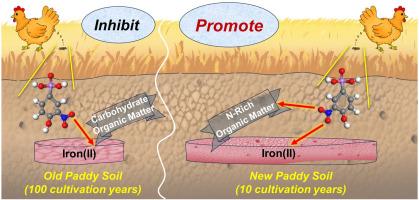N-rich organic matter–iron(II) complexation drives efficient roxarsone stabilization in new paddy soils
IF 7.7
Q2 ENGINEERING, ENVIRONMENTAL
引用次数: 0
Abstract
Roxarsone (ROX), a widely used organic arsenic feed additive, enters paddy soils through animal manure fertilizer, posing serious risks to environmental and human health. However, the underlying mechanisms of ROX stabilization, particularly the role of soil cultivation duration, remain poorly understood. Here, we compared ROX stabilization in new paddy soil (NPS, 10-year cultivation) and old paddy soil (OPS, 100-year cultivation). NPS exhibited higher ROX stabilization ability than OPS, as evidenced by a 1.5-fold higher adsorption rate constant, a 28-fold higher organic carbon-normalized partition coefficient (Koc) and retention of 13-fold more arsenic in the residual fraction (non-extractable arsenic). The improved adsorption and stability in NPS were mainly due to complex formation between nitrogen-rich organic matter and Fe(II). In-situ spectroscopic and electrochemical analyses revealed that the complex promote ROX fixation by forming a Fe(II)-ROX-N ternary configuration. This structure was derived from the bidentate binuclear binding of As(V) with iron sites and deprotonated N-containing functional groups. These findings provided mechanistic insights into organic arsenic adsorption in soils and offered theoretical guidance for optimizing soil composition management strategies.

富氮有机质-铁(II)络合作用在新型水稻土中驱动高效噻沙酮稳定
Roxarsone (ROX)是一种广泛使用的有机砷饲料添加剂,通过动物粪便肥料进入水稻土,对环境和人类健康构成严重风险。然而,ROX稳定的潜在机制,特别是土壤耕作时间的作用,仍然知之甚少。本研究比较了新水稻土(NPS,栽培10年)和旧水稻土(OPS,栽培100年)的ROX稳定性。NPS的吸附速率常数高1.5倍,有机碳归一化分配系数(Koc)高28倍,残留部分(不可提取的砷)的砷保留率高13倍,表现出比OPS更高的ROX稳定能力。NPS中富氮有机质与Fe(II)之间形成络合物是提高吸附性能和稳定性的主要原因。原位光谱和电化学分析表明,配合物通过形成Fe(II)-ROX-N三元结构促进ROX的固定。这种结构来源于As(V)与铁位点和去质子化含n官能团的双齿双核结合。这些发现为有机砷在土壤中的吸附提供了机理认识,并为优化土壤成分管理策略提供了理论指导。
本文章由计算机程序翻译,如有差异,请以英文原文为准。
求助全文
约1分钟内获得全文
求助全文
来源期刊

Journal of hazardous materials advances
Environmental Engineering
CiteScore
4.80
自引率
0.00%
发文量
0
审稿时长
50 days
 求助内容:
求助内容: 应助结果提醒方式:
应助结果提醒方式:


